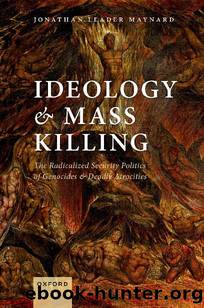Ideology and Mass Killing by Jonathan Leader Maynard

Author:Jonathan Leader Maynard [Maynard, Jonathan Leader]
Language: eng
Format: epub
Publisher: OUP Oxford
Published: 2022-05-26T00:00:00+00:00
The Rank-and-File Bombers
The rank-and-file aircrews of the Allied area bombing campaign played a very different role from rank-and-file agents in most other cases of mass killing. For a start, area bombing was a form of what Laia Balcells labels âindirect violenceâ198: the RAF and USAAF bomber crews did not confront civilian victims face-to-face, but from a height of several kilometres.199 As Charles Lindbergh, then serving as an informal advisor to General Arnold, observed across two entries in his wartime journals from 1944:
You press a button and death flies down ⦠It is like listening to a radio account of a battle on the other side of the earth. It is too far away, too separated to hold reality ⦠In modern war one kills at a distance, and in doing so does not realize that he is killing.200
Such âindirectâ violence is always likely to lessen the difficulty of ideological justification amongst rank-and-file agents. Most obviously, as Lindbergh suggests, killing-at-a-distance reduces many of the fundamental psychological obstacles to killing civilians that arise in proximate massacresâobstacles that ideological legitimation may help overcome. In addition, indirect violence increases the epistemic dependence of rank-and-file agents on their elite superiors: it is easier for elites to ideologically construct the meaning of violence when the rank-and-fileâs actual experience of the ultimate effects of that violence is so limited.
Second, by contrast, the bombing aircrews were not distant from genuine warfare. Unlike many perpetrators of mass killing, who kill civilians far from any real battlefront, the aircrews risked death daily in carrying out bombing raids, with a life expectancy measured in weeks, and only a quarter of airmen completing their assigned tour of duty.201 As Kevin Wilson writes: âit took courage of the kind itâs difficult to comprehend today to fly into the apparently unbroken wall of bursting flak that was Berlin or the Ruhr, thenâhaving survived by an apparent miracleâdo it again the next night or the one after thatâ.202 Bomber crews were full participants in a very real war, who spent much of their time engaged in direct operations against military and industrial targets, or evading deadly assaults by enemy fighter formations. The strains of aircrew life also made reflection on the specific moral and strategic character of bombing different targets neither especially likely nor psychologically helpful. âThe men who fared bestâ, Hastings observed, âwere those that did not allow themselves to think at all.â203
Third, while violent coercion was minimal, Allied area bombing is as close as we get to a campaign of mass killing that could be micromanaged by central authorities. Reluctant participants could have sought transfer to other duties or have applied to different service arms on normative grounds,204 but once in the bombing aircrews, only a dishonourable discharge provided an exit pathâand this involved abandoning front-line service in the war effort entirely, which few airmen considered palatable. Aircrew were not required to have any detailed understanding of the strategic and moral arguments elites saw as justifying area bombing, only to have mastered the skills required to operate the bombers and carry out terse, abstract mission directives.
Download
This site does not store any files on its server. We only index and link to content provided by other sites. Please contact the content providers to delete copyright contents if any and email us, we'll remove relevant links or contents immediately.
| Automotive | Engineering |
| Transportation |
Machine Learning at Scale with H2O by Gregory Keys | David Whiting(3950)
Never by Ken Follett(3698)
Urban Outlaw by Magnus Walker(3302)
OPNsense Beginner to Professional by Julio Cesar Bueno de Camargo(3225)
Sapiens and Homo Deus by Yuval Noah Harari(2939)
Will by Will Smith(2730)
A Short History of Nearly Everything by Bryson Bill(2574)
Hooked: A Dark, Contemporary Romance (Never After Series) by Emily McIntire(2458)
Rationality by Steven Pinker(2225)
Borders by unknow(2141)
Holy Bible (NIV) by Zondervan(2054)
The Becoming by Nora Roberts(2026)
The One Percenter Encyclopedia by Bill Hayes(1752)
Freedom by Sonny Barger(1740)
HBR's 10 Must Reads 2022 by Harvard Business Review(1736)
A Short History of War by Jeremy Black(1722)
Five Ways to Fall by K.A. Tucker(1665)
Girls Auto Clinic Glove Box Guide by Patrice Banks(1653)
Go Tell the Bees That I Am Gone by Diana Gabaldon(1643)
